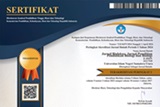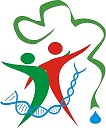Canva-assisted biotechnology module based on Marsialap Ari’s local wisdom: The endeavor to improve students' creativity skills
Abstract
The basis of this research is that the teaching materials created by teachers in the Southern Tapanuli area have not incorporated many models based on local wisdom such as Dalihan Natolu and Marsialap ari. These teaching materials can be utilized to evoke students’ cultural values, character, and creativity. Efforts to enhance student creativity in biotechnology learning still need to be implemented, as the learning process is too fast and students’ understanding is still lacking. This research aims to determine whether the module developed is suitable for use as Biotechnology teaching material in high school based on the BNSP assessment criteria. Additionally, it aims to observe the effectiveness of students using a biology module based on local wisdom (Marsialap ari) assisted by the Canva application on biotechnology material as teaching material in learning for the tenth-grade students in SMA/MA majoring in science. This research is a 4D model development research with research procedures that include defining, designing, developing, and disseminating. The research results can be obtained from the data obtained from several validators, both quantitatively and qualitatively, using descriptive statistical analysis calculations. The module validity of 76.6 - 100% is categorized as valid criteria and LKPD content validity of 80 - 93% is categorized as valid criteria. The product of this research is a biotechnology teaching module based on the local wisdom of Marsialap ari for SMA/MA students. The effectiveness of the module was evaluated based on student performance, with an average of 95 categorized as effective and an average of 90.3 categorized as very creative. In conclusion, the Biotechnology module based on Marsialap ari, assisted by the Canva application, is declared valid for use in studying biology and can enhance students’ creativity in learning biology.
Keywords
Full Text:
PDFReferences
Aprilia, M., Lidinillah, D.A.M., & Giyartini, R. (2021). Pengembangan instrumen penilaian kreativitas siswa melalui analisis rasch model di sekolah dasar. Jurnal Basicedu, 5(4), 2302–2310. https://doi.org/10.31004/basicedu.v5i4.1199
Arends, R. (2012). Learning to teach 9th ed. Mc-Graw Hill.
Banjar, A., Xu, X., Iqbal, M.Z., & Campbell, A. (2023). A systematic review of the experimental studies on the effectiveness of mixed reality in higher education between 2017 and 2021. Computers & Education: X Reality, 3, 100034. https://doi.org/10.1016/j.cexr.2023.100034
Birgili, Y.S.B. (2015). Creative and critical thinking skills in problem-based learning environments. Journal of Gifted Education and Creativity, 2(2), 71–71. https://doi.org/10.18200/JGEDC.2015214253
Budiarti, R.S., & Harlis, D.N. (2020). High order thinking skills for biology education: Applied microbiology learning videos based on Jambi lokal wisdom. Universal Journal of Educational Research, 8(2), 689–694. https://doi.org/10.13189/ujer.2020.080242
Feng, Q., Luo, H., Li, W., Chen, T., & Song, N. (2023). Effects of gender diversity on college students’ collaborative learning: From individual gender to gender pairing. Heliyon, 9(6). https://doi.org/https://doi.org/10.1016/j.heliyon.2023.e16237
Fianingrum, F., Novaliyosi, N., & Nindiasari, H. (2023). Kurikulum merdeka pada pembelajaran matematika. Edukatif : Jurnal ilmu pendidikan, 5(1), 132–137. https://doi.org/10.31004/edukatif.v5i1.4507
Han, W., & Abdrahim, N.A. (2023). The role of teachers’ creativity in higher education: A systematic literature review and guidance for future research. Thinking Skills and Creativity, 48, 101302. https://doi.org/10.1016/j.tsc.2023.101302
Hadi, K., & Dazrullisa. (2018). Pengembangan bahan ajar biologi berbasis kearifan lokal. Prosiding Seminar Nasional Biotik 2018, 822–828.
Hogan, D., & O’Flaherty, J. (2022). Exploring the nature and culture of science as an academic discipline: implications for the integration of education for sustainable development. International Journal of Sustainability in Higher Education, 23(8), 120–147. https://doi.org/10.1108/IJSHE-06-2021-0236
Khomariah, N. (2023). Marsialap ari: Tradisi masyarakat mandailing di Kampung Air Putih Nagari Kinali Kecamatan Kinali Kabupaten Pasaman Barat (1972-2021). Jurnal Riset Dan Publikasi Mahasiswa, 3(1), 51–67.
Kun, Prasetyo Z. (2013). "Pembelajaran Sains Berbasis Kearifan Lokal " Seminar Nasional Fisika dan Pendidikan Fisika Ke-3, Surakarta, Indonesia. Universitas Sebelas Maret.
Lawe, Yosefina U., Noge, M. D., Wede, E., Itu, I. M. (2021). Penggunaan bahan ajar elektronik multimedia berbasis budaya lokal pada tema Daerah Tempat Tinggalku untuk meningkatkan kemampuan berpikir tingkat tinggi siswa Sekolah Dasar. Jurnal Ilmiah Pendidikan Citra Bakti. Vol. 8 (1), 92-102. https://doi.org/10.38048/jipcb.v8i1.104
Marrone, R., Taddeo, V., & Hill, G. (2022). Creativity and artificial intelligence: A student perspective. Journal of Intelligence, 10 (3), 65. https://doi.org/10.3390/jintelligence10030065
Ma, J., Wang, Y., Joshi, S., Wang, H., Young, C., Pervez, A., Qu, Y., & Washburn, S. (2024). Using immersive virtual reality technology to enhance nursing education: A comparative pilot study to understand efficacy and effectiveness. Applied Ergonomics, 115, 104159. https://doi.org/10.1016/j.apergo.2023.104159
Maor, R., Paz-Baruch, N., Grinshpan, N., Milman, A., Mevarech, Z., Levi, R., Shlomo, S., & Zion, M. (2023). Relationships between metacognition, creativity, and critical thinking in self-reported teaching performances in project-based learning settings. Thinking Skills and Creativity, 50, 101425. https://doi.org/10.1016/j.tsc.2023.101425
Nasution, S. (2017). Berbagai Pendekatan Dalam Proses Belajar & Mengajar (18th ed.). Bumi Aksara.
Nurrahmi, Rafika. (2018). Pengembangan Modul Berbasis Kearifan Lokal Daerah Istimewa Yogyakarta Untuk Siswa Kelas III Sekolah Dasar. Jurnal Pendidikan Guru Sekolah Dasar Vol. 7 (17). https://journal.student.uny.ac.id/ojs/index.php/pgsd/article/view/11033
Oje, A.V., Hunsu, N.J., & May, D. (2023). Virtual reality assisted engineering education: A multimedia learning perspective. Computers & Education: X Reality, 3, 100033. https://doi.org/10.1016/j.cexr.2023.100033
Pulungan, D.Z. (2018). Budaya “Marsialap Ari” refleksi pembentukan karakter masyarakat mandailing. Seminar Nasional Pendidikan Bahasa Indonesia, 348–355.
Rahman T., (2018). Aplikasi Model-model Pembelajaran dalam Penelitian Tindakan Kelas (1st ed.). CV. Pilar Nusantara.
Ramdani, A., Utami, S.D., Efendi, I., Dewi, I.N., & Rohyani, I.S. (2020). Local wisdom integrated biology learning program as an alternative to increase generic science skills. Journal of Physics: Conference Series, 1521(4). https://doi.org/10.1088/1742-6596/1521/4/042027
Ririn, D. (2015). Analisis psikometri instrumen pengukuran kreativitas dengan skala pengukuran kreativitas utami munandar. Jurnal Psikologi, 1-9.
Rummar, M. (2022). Kearifan Lokal dan Penerapannya di Sekolah. Jurnal Syntax Transformation, 3 (12). https://doi.org/10.46799/jst.v3i12.655
Sagala, S. (2017). Konsep dan makna pembelajaran : untuk membantu memecahkan problematika belajar dan mengajar (13th ed.). Alfabeta.
Sapitri, L. (2022). Studi literatur terhadap kurikulum yang berlaku di Indonesia saat pandemi COVID-19. Inovasi Kurikulum, 19(2), 227–238. https://doi.org/10.17509/jik.v19i2.44229
Shufa, Naela K. F. (2018). Pembelajaran Berbasis Kearifan Lokal Di Sekolah Dasar: Sebuah Kerangka Konseptual. Inopendas Jurnal Ilmiah Kependidikan. Vol. 1 No. 1, Hal. 48-53.
Situmorang, S.M.S., Rustaman, N.Y., & Purwianingsih, W., (2020). Identifikasi kreativitas siswa sma dalam pembelajaran levels of inquiry pada materi sistem pernapasan melalui asesmen kinerja. Dikdaktika Biologi, 4(1), 35–43.
Slameto. (2015). Belajar dan faktor-faktor yang mempengaruhinya (revisi, Vol. 6). Rineka Cipta.
Thabroni, G. (2022). Berpikir kreatif (creative thinking) – pengertian, indikator, tahap, dsb. https://serupa.id/berpikir-kreatif-creative-thinking-pengertian-indikator-tahap-dsb/
Thiagarajan, S. Semmel, D.S., & Semmel, M.I. (1974). Instructional development for training teachers of exceptional children: A sourcebook. Indiana University.
https://files.eric.ed.gov/fulltext/ED090725.pdf
Wagiran. (2009). Pengembangan Model Pendidikan Kearifan Lokal di Wilayah Propinsi DIY dan Mendukung Perwujudan Visi Pembangunan DIY Menuju tahun 2025. Yogyakarta: Setda Provinsi DIY.
Wahyuni, N dan Ninawati, M. (2020). Pengembangan Bahan Ajar Berbasis Kearifan Lokal Untuk Meningkatkan Kemampuan Multiliterasi Peserta Didik Di Daerah Tertinggal. Laporan Penelitian Dasar Keilmuan. https://simakip.uhamka.ac.id/download?type=penelitianlaporan&id=668&nomor=1
Walle, J.A.V.D. (2008). Matematika sekolah dasar dan menengah : Pengembangan Pengajaran (6th ed.). Erlangga.
Winangun, I.MA. (2020). Media berbasis budaya lokal dalam pembelajaran IPA SD. Edukasi: Jurnal Pendidikan Dasar, 1(1), 65-72.
Yang, X. (2023). Creating learning personas for collaborative learning in higher education: A Q methodology approach. International Journal of Educational Research Open, 4. https://doi.org/10.1016/j.ijedro.2023.100250
DOI: http://dx.doi.org/10.30821/biolokus.v6i2.3114
Refbacks
- There are currently no refbacks.
Copyright (c) 2024 Jurnal Biolokus: Jurnal Penelitian Pendidikan Biologi dan Biologi
indexed by :












